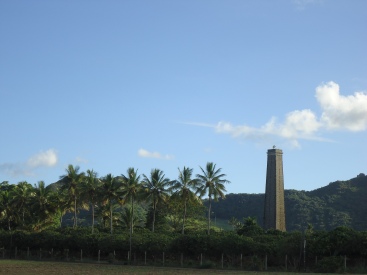Unbelievably one year has passed since I was in Mauritius…now as I attempt to write up I find myself every now and then thinking ‘what was I doing this time last year…’. Thanks to my ‘short and sweet’ field diary (read, spreadsheet), I know that today I was in the National Archives and had found some documentation of several Mauritian colonial administrators who wished to be transferred to Fiji. After my exciting week in the archives (really!) I took a drive around the island at the weekend to take a look at some sugar factory ruins. I’m interested in the toponymy of Mauritian settlements and physical landmarks and given its fractured colonial past (Portuguese, Dutch, French and British), one would expect a real linguistic mélange of place names. Today, the vast majority of Mauritian place names are in French or English. There are though at least three place names that retain their original Portuguese names – the autonomous outer island of Rodrigues, named after the Portuguese explorer Diogo Rodrigues, Cargados Carajos, one of Mauritius’ outer island dependencies and of course the Mascarene Islands, of which Mauritius, Rodrigues, Réunion and Cargados Carajos are a part, which were named after the Portuguese navigator Pedro Mascarenhas.

Pedro Mascarenhas (Source: Faria e Sousa, M. (1695) Portuguese Asia , or the history of the discovery and conquest of India by the Portuguese. [electronic])

Fort Frederik Hendrik, south-east Mauritius
Travelling around the island, the place names given by those first Dutch settlers, as seen in Valentijn’s Kaart van het Eyland Mauritius, circulated in my head. There are a handful of place names in Mauritius (including of course the name ‘Mauritius’ itself) which are of direct Dutch origin, such as Pieter Both and Vandermeersch. But what I found most interesting was the trickle of place names now in French, which were directly translated from their original Dutch names, and whose Dutch origins are now somewhat forgotten. So De Paling Rivier was literally translated as Rivière des Anguilles (Eel River); De Swarte Rivier also literally became Rivière Noire (Black River); likewise De Drie Gebroeders became Les Trois Frères (The Three Brothers). De Groote Limoen Booms Rivier (Large Lemon Tree River) became Rivière des Citrons (Lemon River); and my personal favourite De Bogt Sonder Eyndt (The Bay Without End) became Grand Baie (Grand Bay). Many of the Dutch names were not retained in Francophone form. Coin de Mire, the iconic islet off the north coast of Mauritius, also known in English as Gunner’s Quoin was called De Leest in Dutch, meaning a shoe last. The islet is an ancient basaltic volcanic cone, and as it rises from the sea, you can see (perhaps) why the Dutch thought it resembled a last – a model of the human foot that is used by shoemakers.

Coin de Mire…

…a shoe last
There is also the curious case of the village of Surinam in the south of the island. During my fieldwork in Mauritius, a touring dance troupe from Surinam came to Mauritius and visited the village which bears their country’s name. The Dutch South American colony of Surinam was of course, a part of the ‘Indentured Archipelago’, and recruited some 34,000 Indian indentured labourers beween 1873 and 1916. As part of my work, I am looking at the flow of labourers between colonies, and there is evidence of labourers who indentured in Surinam before migrating to Mauritius during this period. Did they name a village after their former indenture colony?
Nearly all (if not all) sugar estates lent their name to the camp which sprang up adjacent to the plantation where indentured labourers lived. These camps became villages, which still exist today, still bearing the name of the sugar estate – Schoenfeld, Sebastopol, Union Vale, Queen Victoria, L’Avenir and Bonne Mère to name but a few.

Ruins of Queen Victoria sugar estate.
Place names give an intriguing insight into the history of Mauritius, from the Portuguese ‘discovery’ and Dutch settlements to the plantation era of French and British rule. They illustrate how this multi-layered history intersects with both the human and physical geography of the island.
Suriname was give the name after the British took cherry plants from Suriname to be grown in nowadays Mauritius Surinam. The fruit is called ‘Suriname Cherry / Rouisailles’
Les frères Staub sont originaires de Forbach en Moselle, nom qu’ils donnèrent à leur
domaine au quartier de la Rivière du Rempart. Ils possédaient également un domaine
sucrier à Poudre d’Or dénommé Schoenfeld (nom allemand pour Beau Champ en
français).
Merci pour vos commentaires! Very interested by the origin of place names in Mauritius…are you a historian in Mauritius?
Thank you for this interesting piece of history. I am a Surinamer (South America) and just found out a few days ago that there is another place called Surinam(e) in the world.
Dag Lilian – dank u! Yes, it is a village on the south coast of Mauritius. I’m very interested in Suriname – lots of historic connections with Mauritius. Thanks for your comment!